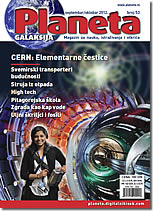| » BROJ 53 |
 |
Godina X
Septembar - Okt. 2012.
|
|
| » Glavni naslovi |
SUMMARY
SummarY
The feature article of this issue
Elementary particles
 |
During June, the researchers at the Geneva CERN centre, thanks to the work of Large Hadron CoLLider, came up with an epochal discovery: it seems that the existence of Higs boson has been confirmed. At the event held on 4 July, all new results have been presented of the research for this most wanted „fugitive" in theoretical physics. Is science really at the threshold to reliably confirm the creation of space?
Scientists from Serbia have for many years participated in the activities of CERN and contributed to its work, including scientists from: the Institute for Physics Zemun, Scientific Institute Vinča, the Faculty of Natural Sciences and Mathematics Belgrade, the Faculty of Electrical Engineering Belgrade. Fulltime employees at CERN include also the young spouses Vranješ. It is believed that the contribution of Serbian scientists is equal to that of scientists from the other 37 countries.
|
Missions
Ouriosity
|
|
 |
Launched in November 2011, the rover „curiosity" was already at that time the biggest rover to cruise the surface of the Mars in search for traces of possible life there. In order to fulfil its mission, the rover collects samples of soil in the areas with conditions favourable for life. Equipped with the state of the art scientific equipment, on 6 August it landed on the Mars. The article speaks of the objectives of this mission.
|
Space conquest
Transporters of the future |
|
 |
The UK company „Reaction Engines Ltd" has been working for three decades on the development of a space-plane that could propel itself from a conventional take off runway using the power of its engines, accelerate to 5.5 mah and reach the low Earth's orbit. Specifically, it is the „Skylon" space-plane which will use special hybrid engines and hydrogen as fuel.
„Skylon" is a space transporter of cylindrical shape, constructed of composite carbon fibres. |
Energy
Energy from waste
|
|
 |
Waste management implies control over waste generation and its storage and sorting, processing and use. All of this is done for the purpose of producing secondary raw materials and energy. Waste management is based on the socalled 3D model - reduce, reuse, and recycle. The energy value of 1kg of waste is equivalent to the energy value of 0.35 l fuel oil, or 275 kg of waste is equivalent to 1 barrel of oil. Incineration can meet up to 15 % of total energy needs. The article speaks of incineration procedures and energy generation. |
Medicine |
|
 |
Nutrition for infants and preschool children In the sensitive period of introducing new foods, after mother's milk, there are concerns and dilemmas.
Dr Mijat Savić, neonatologist and paediatrician of the general hospital Bel Medic, explains the value of mother's milk and what benefits it brings to the child. Making the move to other foods implies the intake of a whole series of substances important for the body's growth: starting with the tastes of vegetables, followed by fruits and grains. Dr Savić also explains the value of meat foods, when and how to introduce it, what are the chances of allergies. He especially recommends joint meals where children and parents eat together, with the option to choose foodstuffs and change eating habits |
Psychology
Autumn blues |
|
 |
External factors are the first reason for the onset of seasonal depression which, physiologically, is explained also by the hormonal misbalance. Psychologist Kristina Brajević Car, consultant at the general hospital Bel Medic in Belgrade, emphasises that this form of seasonal affection disorder can also be an indicator of deeper psychological disorders. The collocultor of „Planeta" explains the methods of diagnosing these states and the therapy administered in such cases. |
Biology
Endangered species in serbia
|
|
 |
In 2009 Serbia adopted its Law on Nature Protection. The Law contains two lists: strictly protected species (a total of 1760), meaning those which are threatened from extinction, and the protected species (a total of 853), mostly plants and amphibian. As a candidate for the EU, Serbia has accepted the programme „Natura", as the fundamental document on the protection of priority assigned species of plants and animals and their habitats. The protection is implemented by the Serbian Institute for Protection of Nature and the Provincial Institute for Protection of Nature, operating under the auspices of the Ministry of the Environment, Mining and Spatial Planning. |
Climate
Major draughts
|
|
 |
Over the past decades draughts are becoming more frequent and intense, often taking turns with periods of floods and other natural disasters. Serbia is for the most part a rural country where draught mostly impacts the yields of field crops, the hydropotential for energy, inland waterways, and other forms of using water resources. Only 35 % of the farming land is irrigated, and this is done by use of obsolete systems. About 70 % of drinking water is from ground water sources because Serbia is poor in internal reusable water resources. |
Palaeontology
Oil shales
|
|
 |
The most abundant reserves of oil shales in Serbia are in the village Subotinac near the town of Aleksinac. This region used to be covered by water of the socalled Serbian lake. Minute algae from this water Botryococcus have a high oil content. They are the key factors in the creation of oil shales, which is a process that began 16 million years ago. This region is presently under research in order to establish whether there are grounds for oil production from this material. |
|
|
|
| » Pratite nas |
 |
 |
|
|

